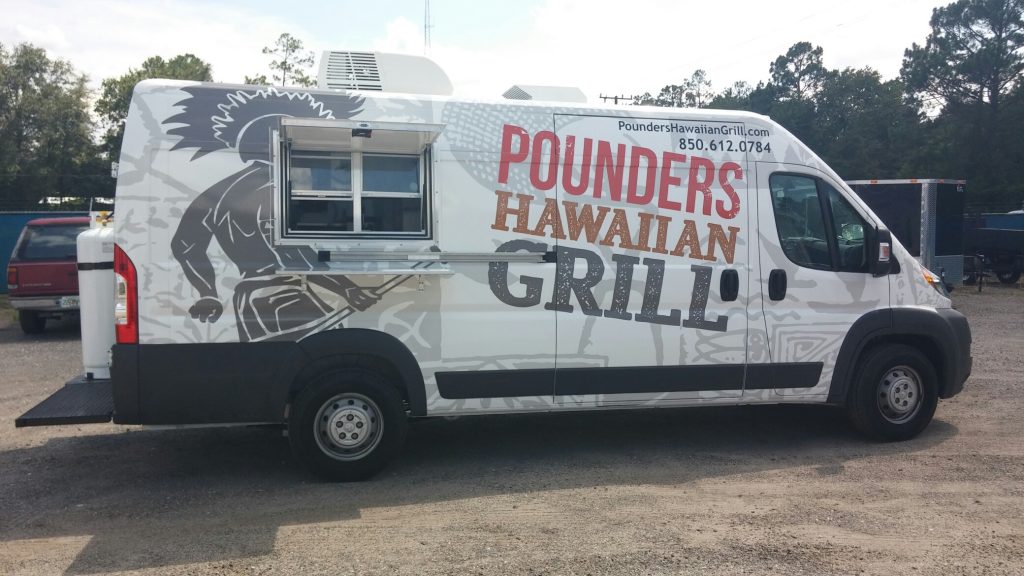Although the total populations of Hawaii is less than 1.5 million people, the culinary footprint of this group of islands is much larger than it’s size. No matter where you go in mainland United States, you can locate a locally owned Hawaiian restaurant. Part of the reason for the popularity is due to the massive amount of tourism to the state. According to news reports, almost 9 million people visited one of the islands in 2017 alone. Many of these tourists return home craving the flavors of the islands they enjoyed while on vacation.

Hawaiian food truck.
Traditional Hawaiian food is simple, yet wide-ranging. The most approachable and arguably most popular option is the plate lunch. In Hawaii, the plate lunch usually features rice, macaroni salad, and some type of grilled meat (chicken, teriyaki beef, and mahi mahi).
In addition to customer demand, the good news for mobile food vendors is that Hawaiian food options can be cooked and served on a food truck easily. Hawaiian food is often cooked on grills near the ocean and served picnic style. This makes Hawaiian food the ideal food to serve on a mobile food unit.
You don’t need to restrict yourself to plate lunches, however. Other options that have worked well on food trucks include: Acai bowls, shaved ice, barbecue, and Poke.
Below is an example of a Sprinter van we converted into a Hawaiian food truck. Since the equipment needed to cook and serve most Hawaiian food is minimal. You can fit all the cooking equipment into a van or truck.
If you want more space and room for employees to operate, we recommend going with a larger truck with an increased serving capacity. Watch the video below to view the entire transformation of this unit. Stick around to the end of the video and you can see what the van looks like with the final branding and wrap.
Any mobile food unit can be completely customized to meet your specific needs and menu requirements. We always recommend developing your menu in advance of purchasing a food truck or trailer. This ensures you have all the cooking equipment pre-installed in order to create and serve your desired menu.
Here’s a summary of the equipment installed on the Hawaiian food truck featured in the above video:
- Fire suppression system / hood
- Char broiler
- Two burner stove
- 3-compartment sink and hand sink
- Propane water heater
- Cabinets for storage
- Refrigerators
- Stainless steel counter top space
- Air conditioning
Advantages
There are some distinct advantages to operating a Hawaiian food truck. First, there is high-familiarity with Hawaiian food due thanks in part to tourism within the state. No matter where you plan to operate there are likely a lot of potential customers that enjoy this type of food from time to time.
The trucks that we see having the most success are those that are able to put a creative twist on well-known food items. Typically food trucks that go too far outside the norm are more difficult to remain profitable longterm.
Another aspect of operating a mobile food business is how fast food can be served. If you’re a first time vendor, you may not have considered that serving speed is an important component of being profitable on a food truck.
As a vendor, you may only have a 1 – 2 hour window when the majority of your sales occur for the day. If you aren’t able to get food prepared and out the window fast, you’ll miss out on a lot of easy sales and hurt your overall profits.
Fortunately, Hawaiian food can be prepared and served extremely fast compared to many other menus. To use the lunch plate as an example, you can prepare mac salad and rice in advance and have it ready to plate. You can also partially cook the meats in anticipation of a lunch or dinner rush.
Finally, be on the look out for regional or ethnic events around Hawaiian food and culture. These cultural events are held annually in many cities across the United States and can be an additional opportunity for increasing sales outside regular service. Here is a list of popular festivals celebrated on the islands.
Challenges
Every real business has challenges. One aspect you’ll need to look into within your market is to identify how many other Hawaiian restaurants and food trucks are operating in your area. If you do find some competitors (you probably will) keep in mind this isn’t a bad thing. You’ll just need to take more time in considering what makes your food different.
Are there any styles of Hawaiian cuisine that could be incorporated into your menu that doesn’t exist elsewhere? Is there a unique island specialty that hasn’t been approached? Can you put a different twist on the macaroni salad that you think enhances the flavor? Are local vendors serving Poke bowls (a food that is increasing in popularity nationally)? These are all great questions to ask and develop ways to address them based on your research.
If you’re thinking about getting a mobile food truck for your business, send us an email or call M&R Specialty Trailers and Trucks directly at 904-397-0246 to discuss your build.
